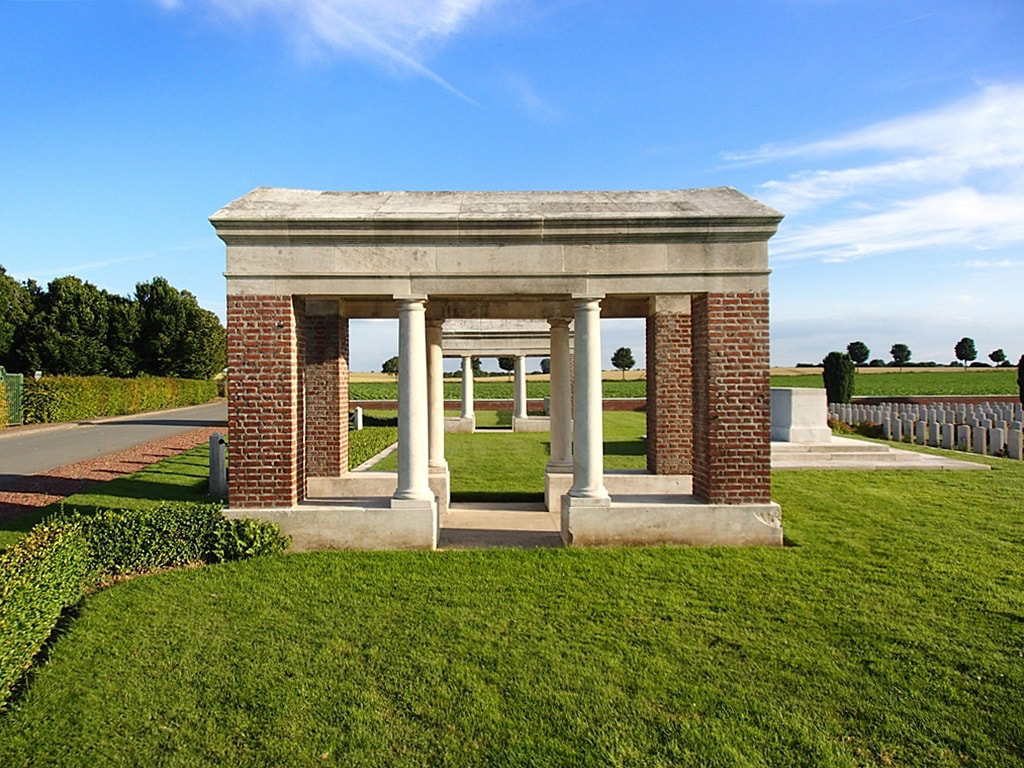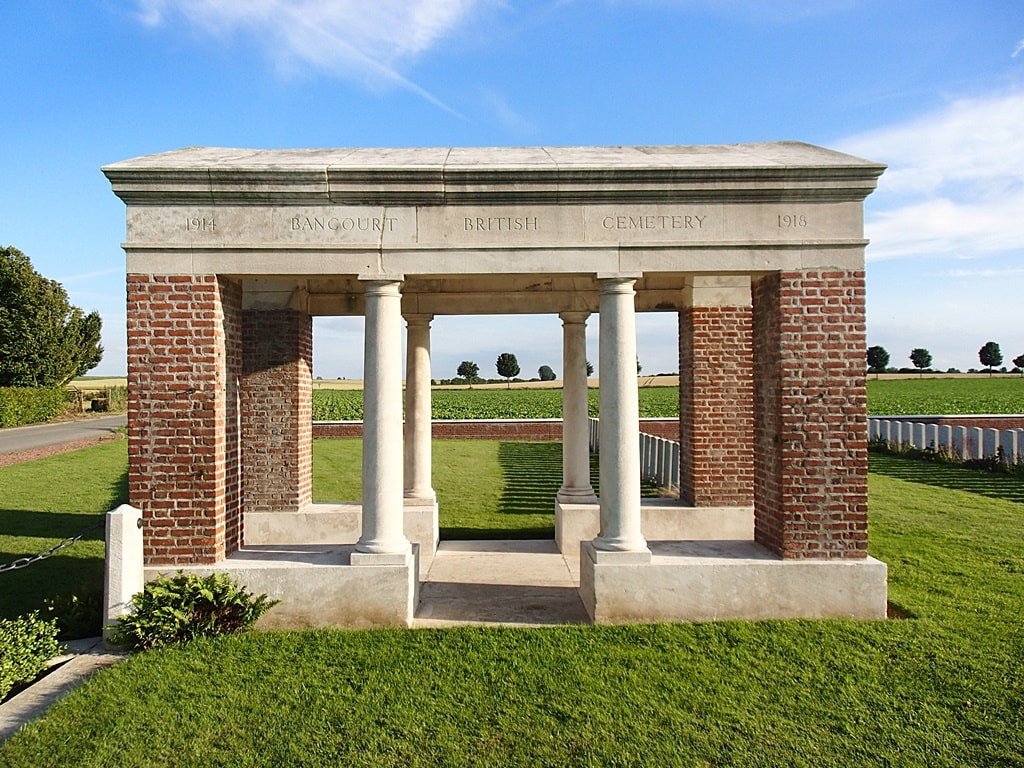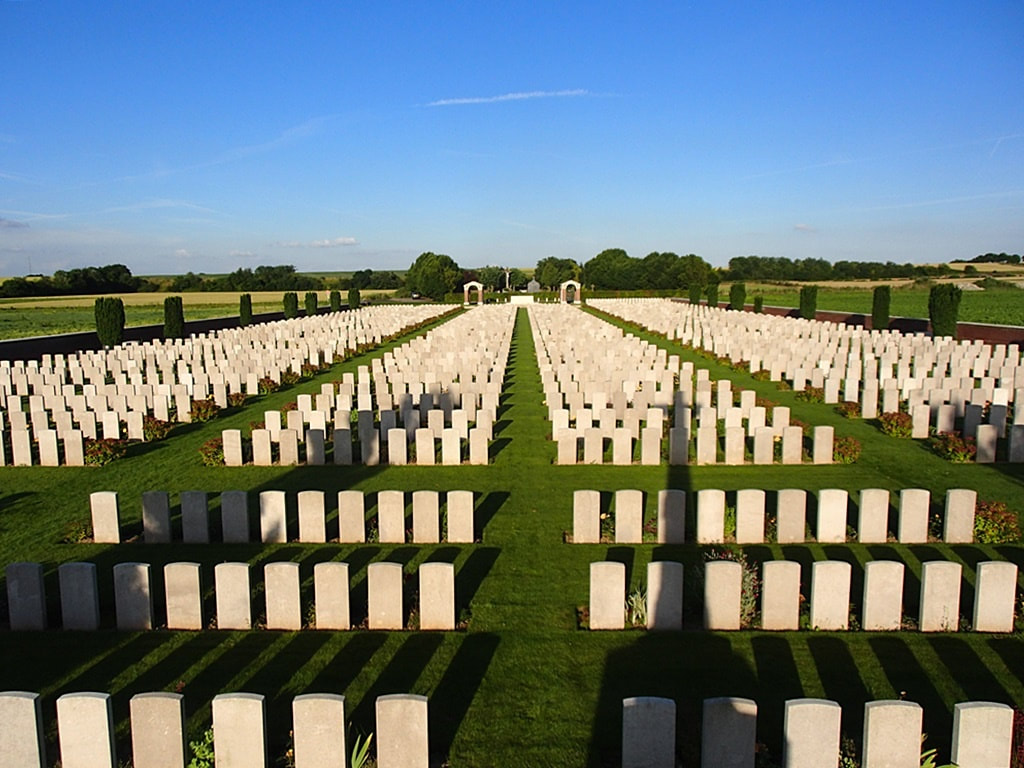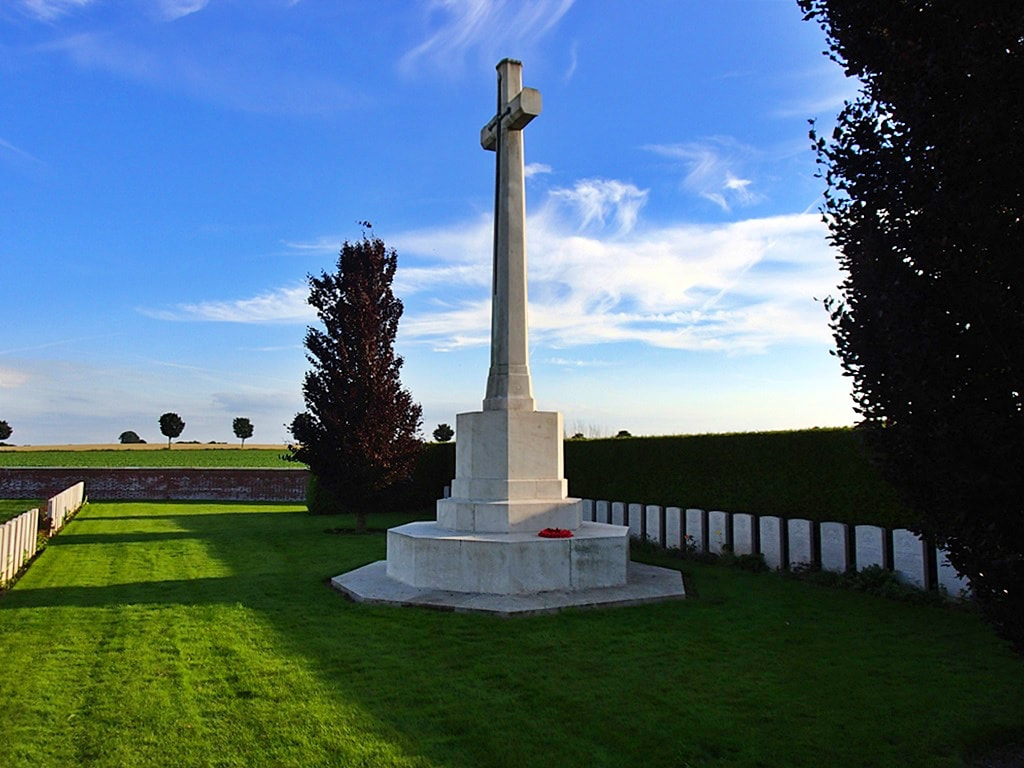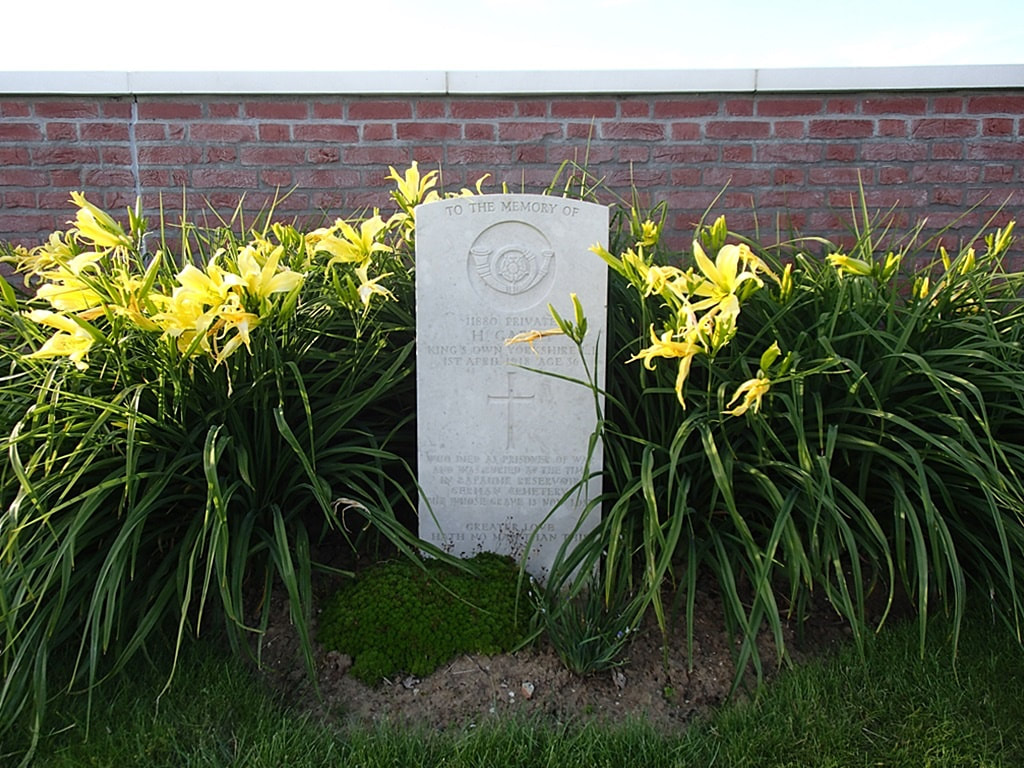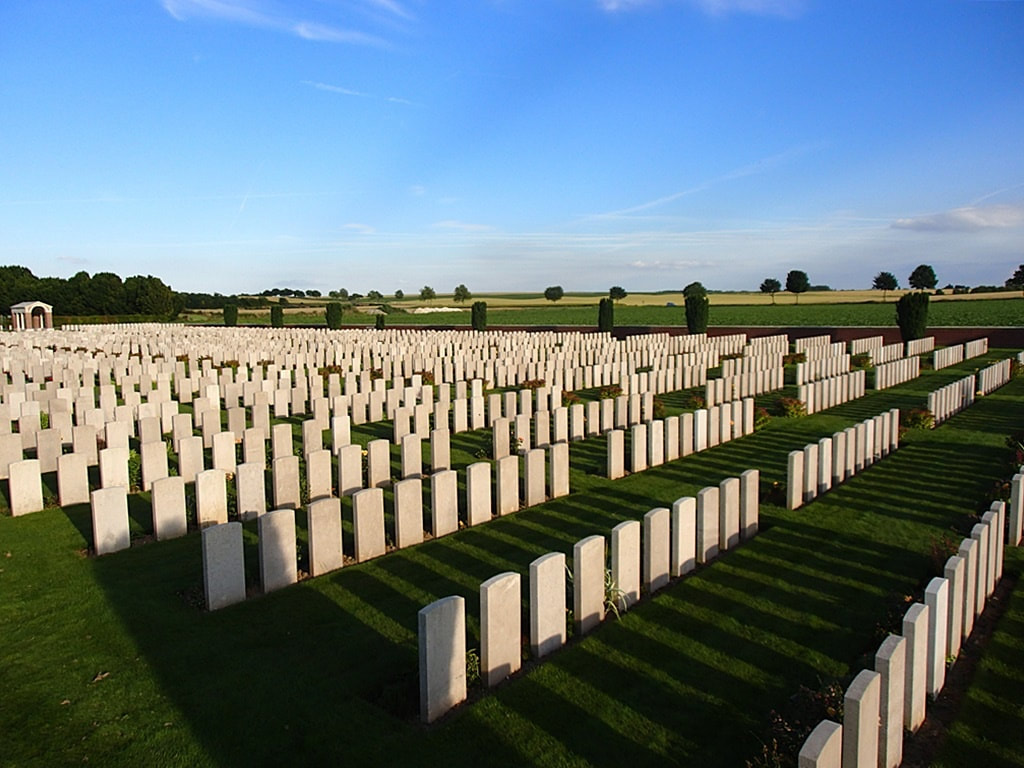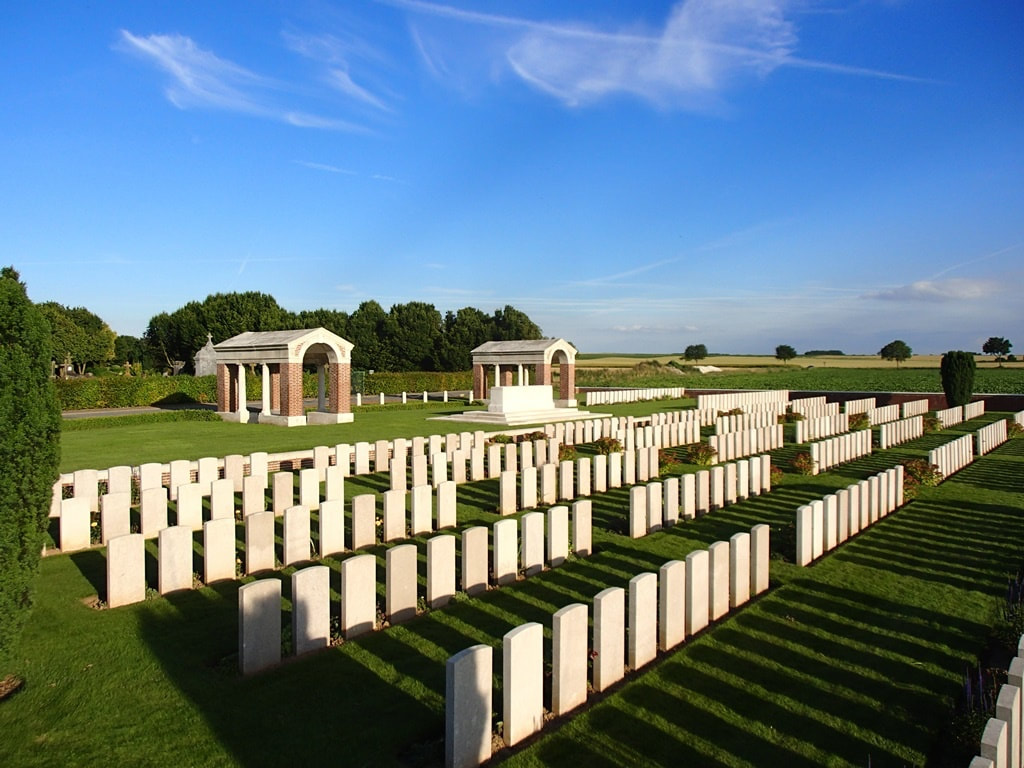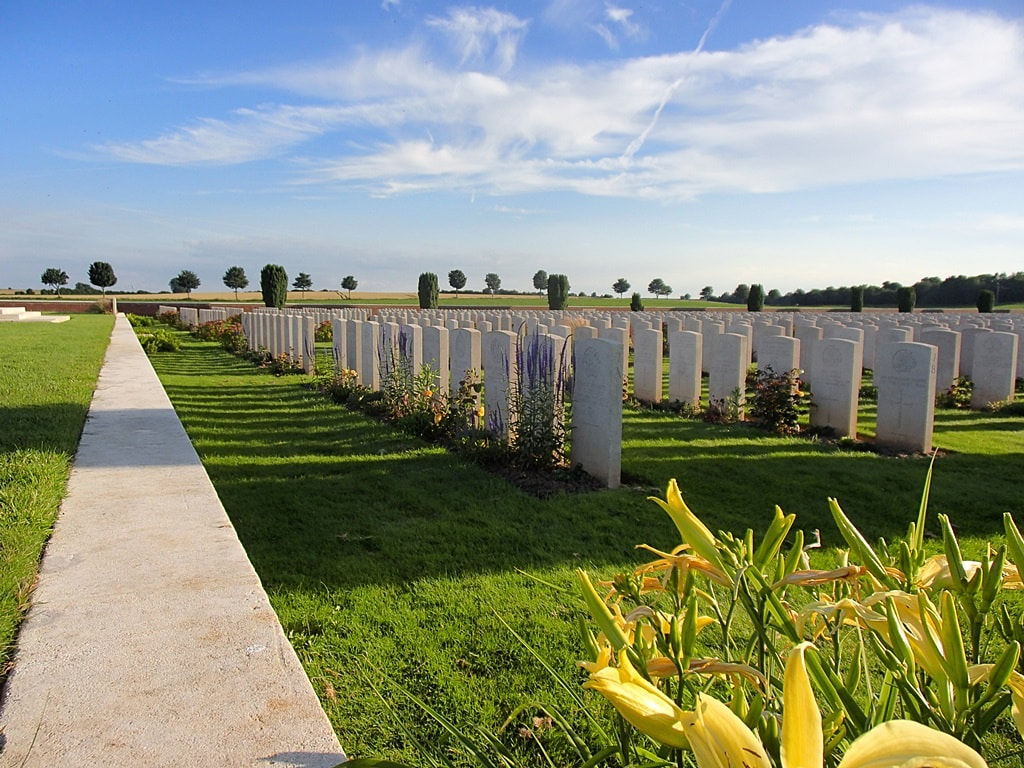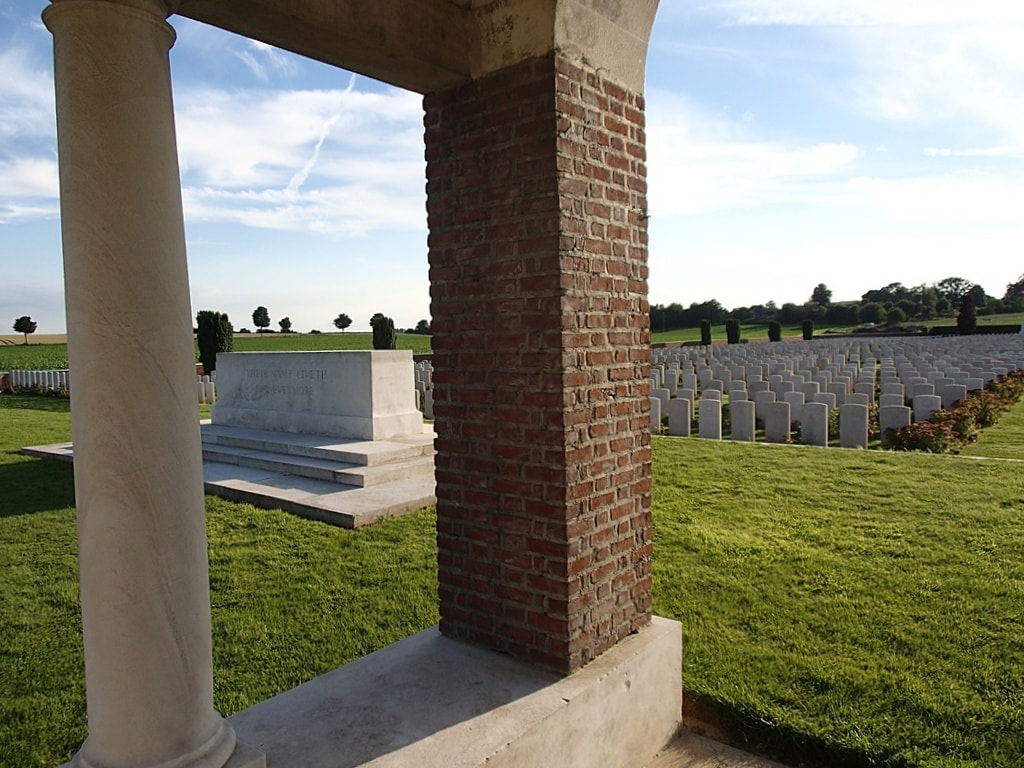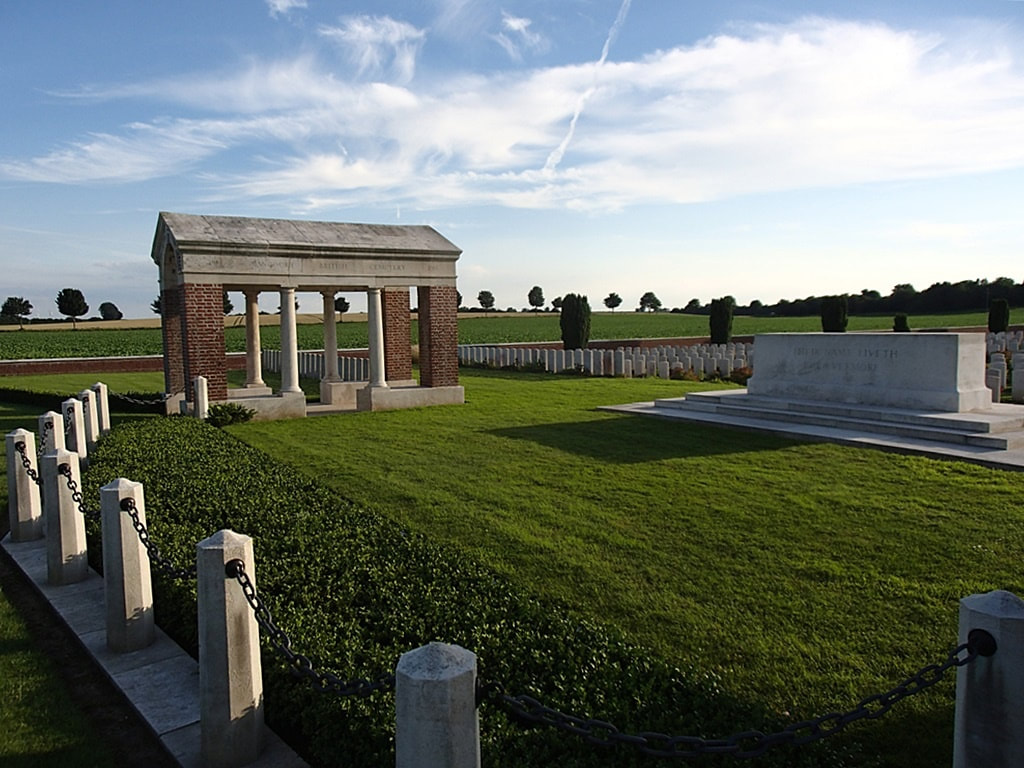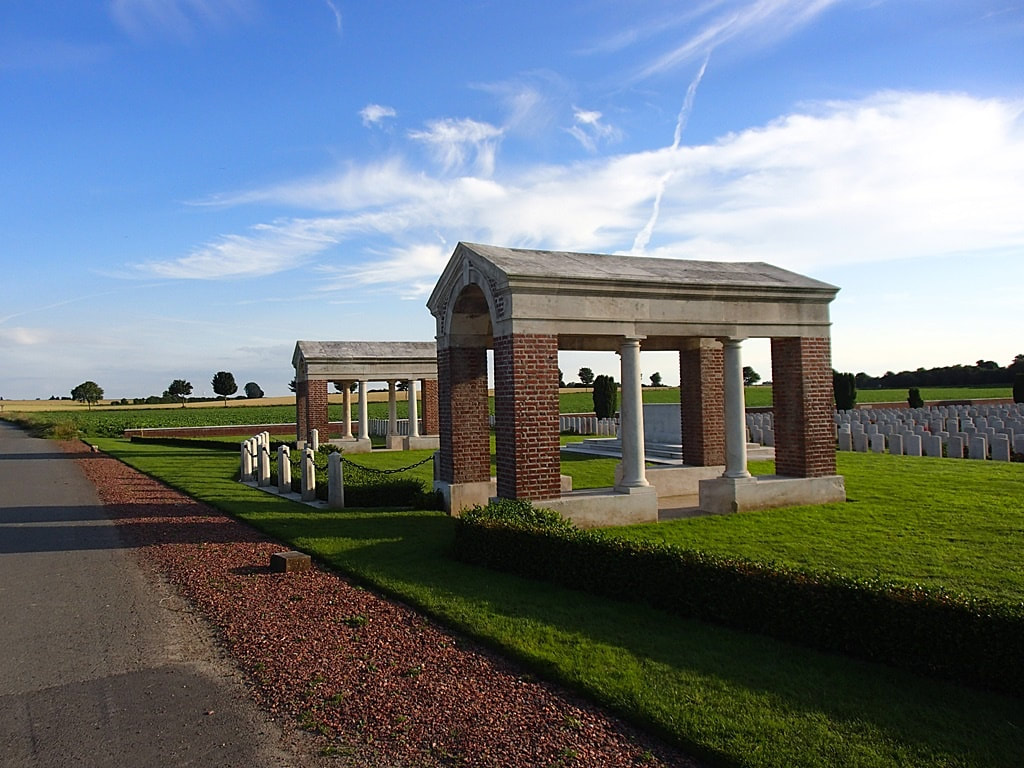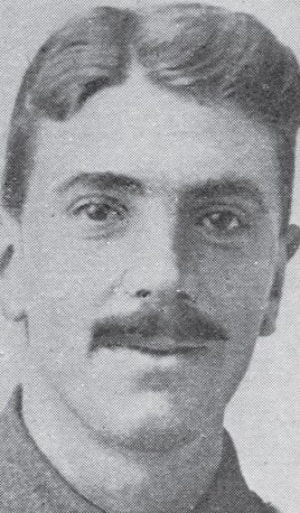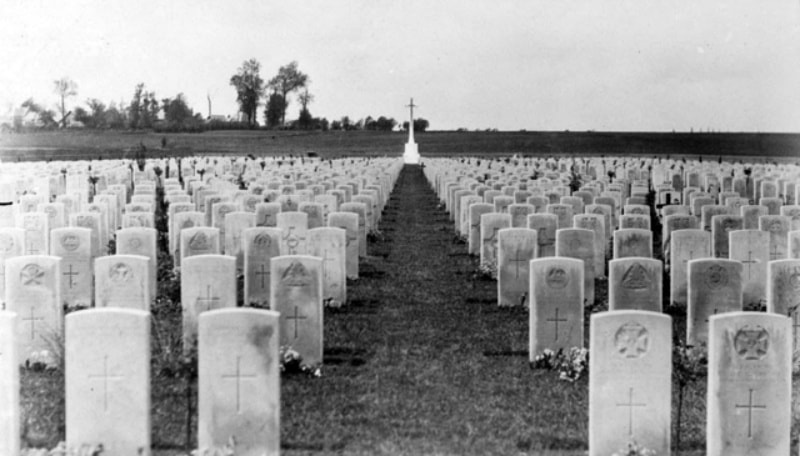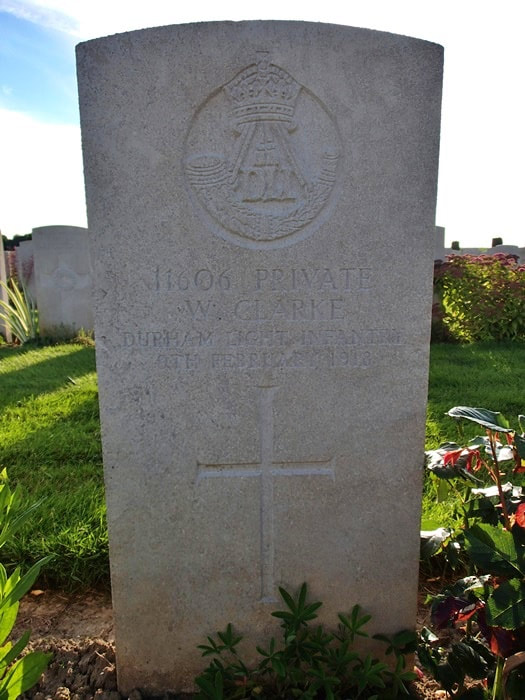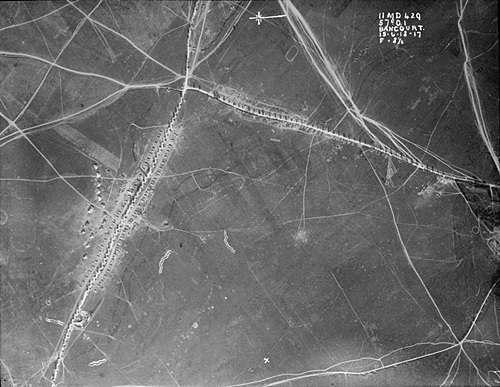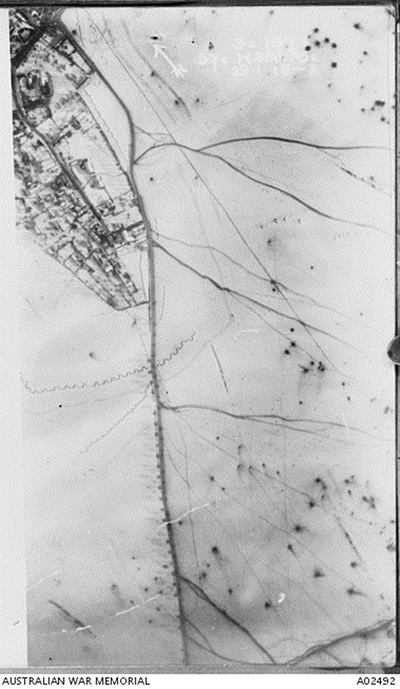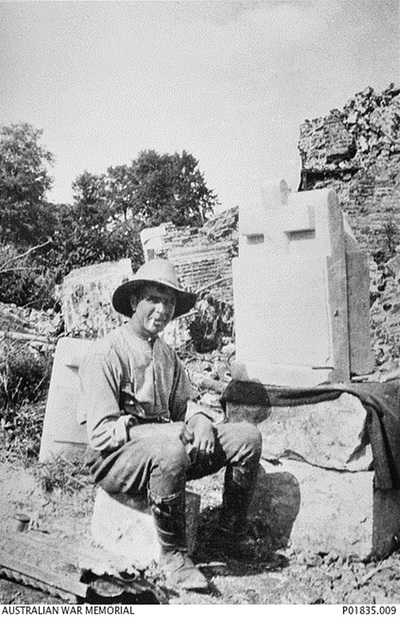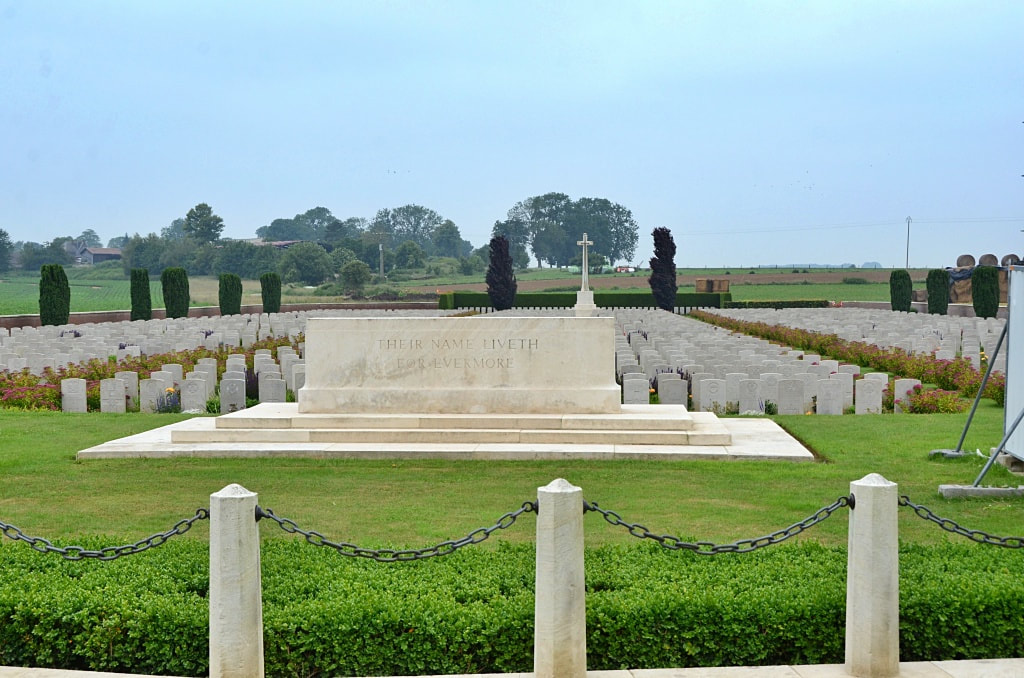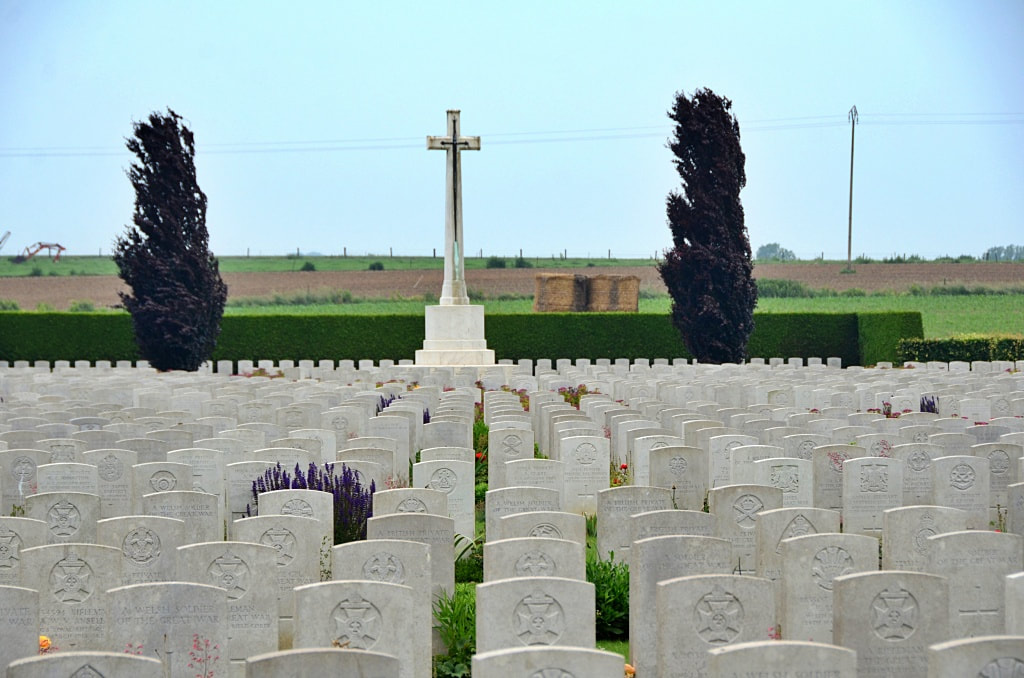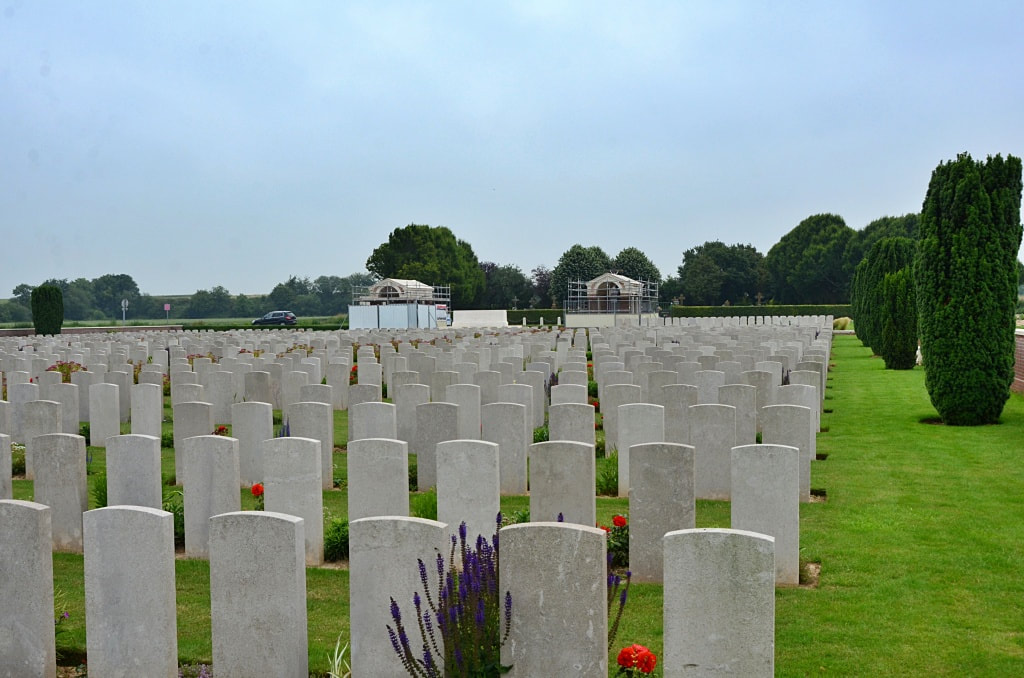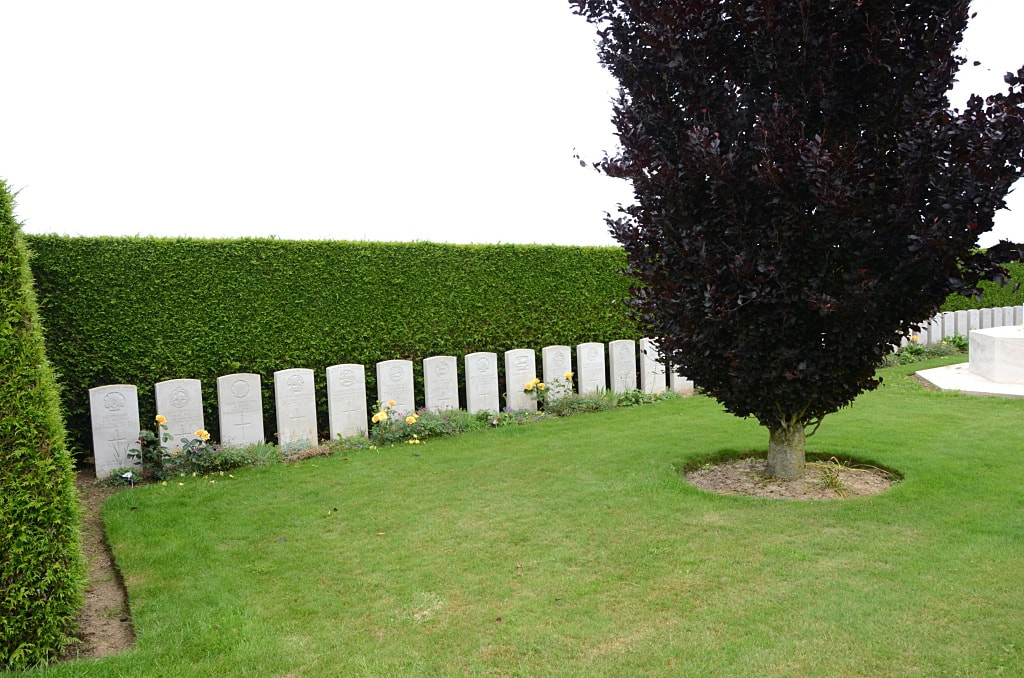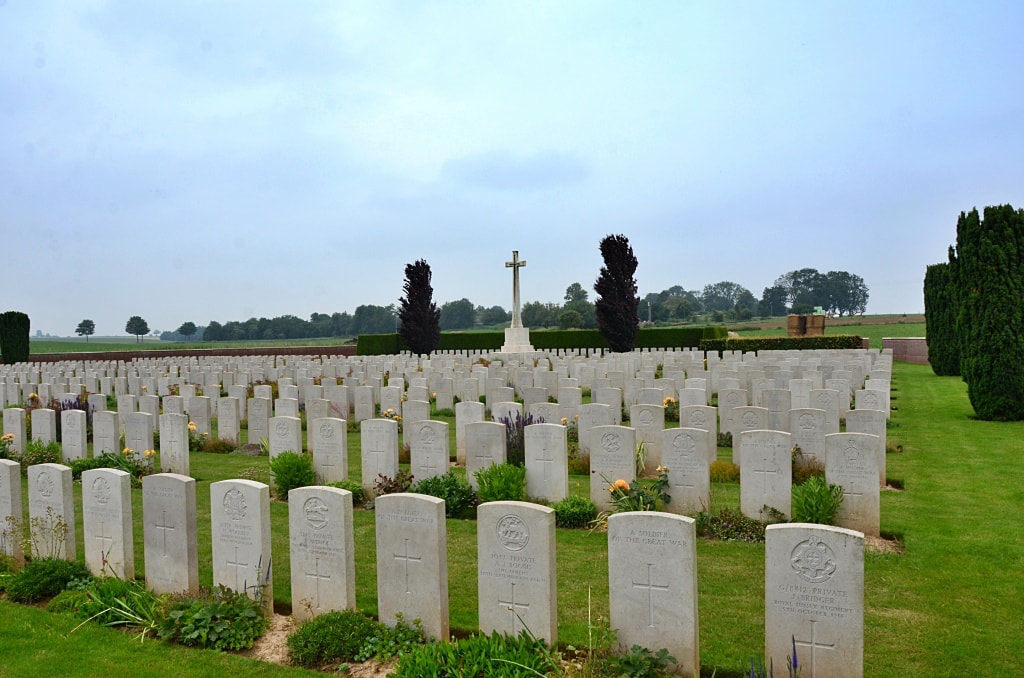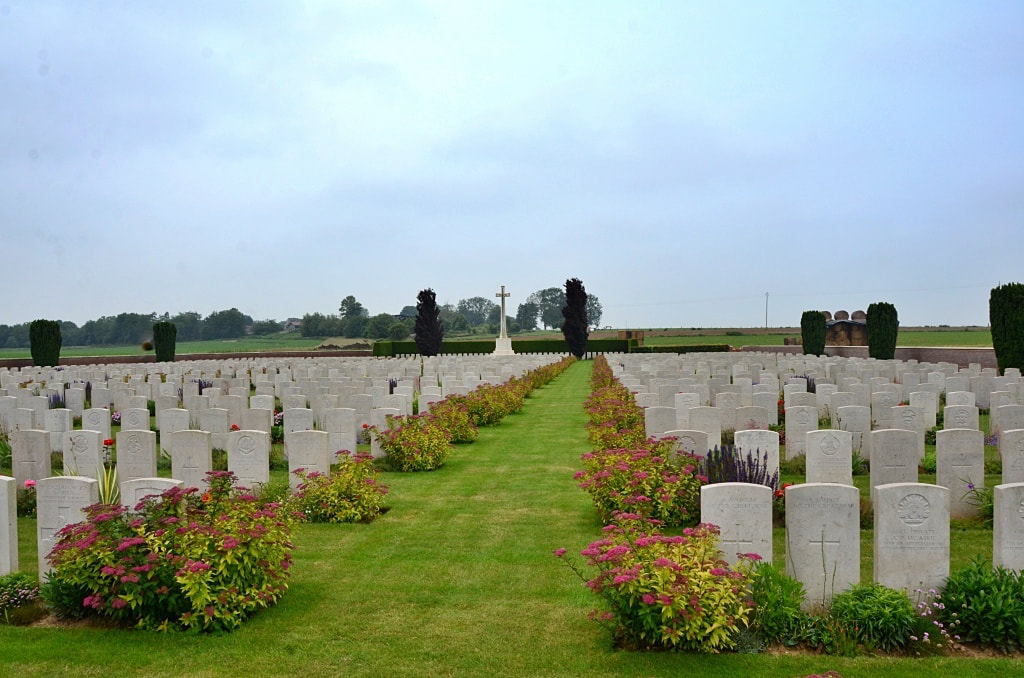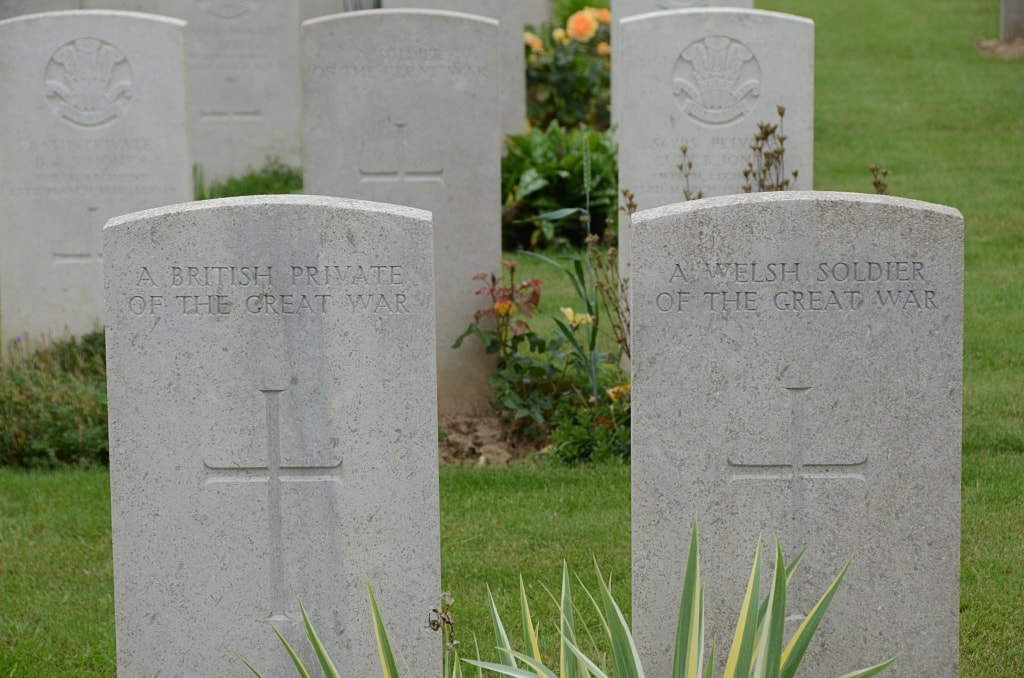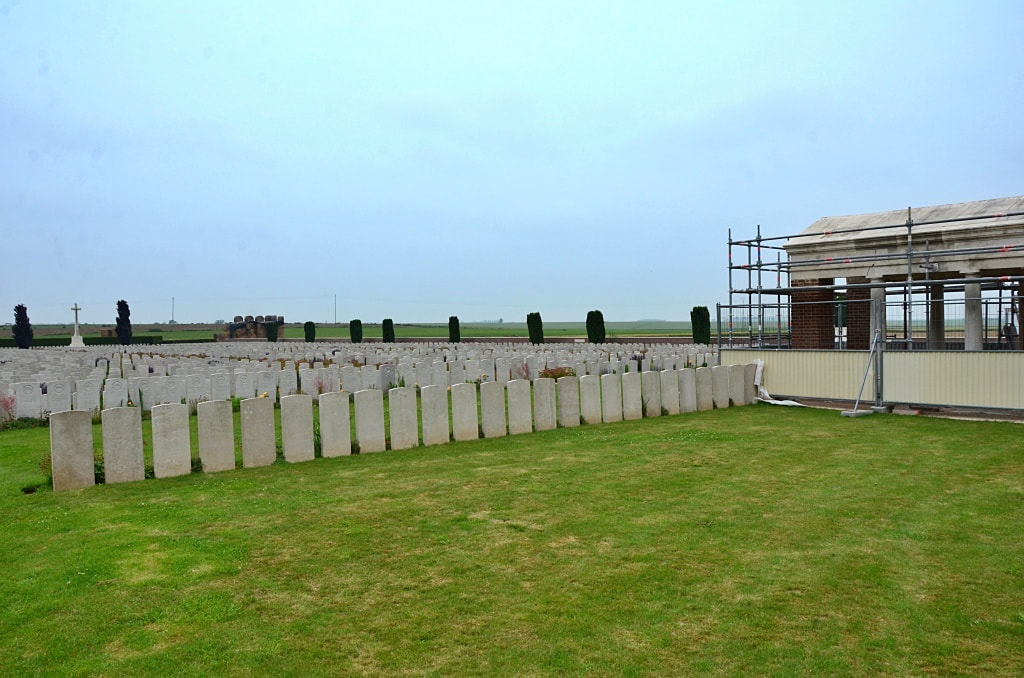BANCOURT BRITISH CEMETERY
Pas De Calais
France
GPS Coordinates: Latitude: 50.10237, Longitude: 2.89748
Location Information
Bancourt is a village which lies approximately 4 Kms due east of Bapaume on the north side of the D7, Bapaume to Bertincourt road. Bancourt British Cemetery is situated east of Bancourt village, 300 metres off the D7 on the north side. The CWGC direction signs on the D7 indicate the best approach to the cemetery.
Visitor Information
Wheelchair access is possible via the main entrance.
Historical Information
Bancourt was occupied by Commonwealth forces in March 1917. It was lost a year later during the German offensive in the spring of 1918, but recaptured by the New Zealand Division (in particular, the 2nd Auckland Battalion) on 30 August 1918.
The cemetery was begun by the New Zealand Division in September 1918; the original cemetery is now Plot I, Rows A and B. The remainder of the cemetery was made after the Armistice when graves were brought in from the battlefields east and south of Bancourt and from certain Allied and German cemeteries, including:-
BAPAUME RESERVOIR GERMAN CEMETERY, on the Bapaume Beaulencourt road, containing the graves of twelve soldiers from the United Kingdom buried by a German Field Ambulance in March and April, 1918, and of seven others and three from New Zealand who fell at the end of August, 1918.
BAPAUME ROAD CEMETERY, BEAULENCOURT, a500 metres South of the Beaulencourt-Gueudecourt road, containing the graves of 20 soldiers from the United Kingdom who fell in October, 1916.
BEAULENCOURT ROAD CEMETERIES, three in number, on the North-East side of Gueudecourt, containing the graves of 88 soldiers from the United Kingdom who fell in the autumn of 1916 or in April, 1917.
CLOUDY TRENCH CEMETERY, GUEUDECOURT, containing the graves of 40 soldiers from the United Kingdom who fell in October or November, 1916.
The five cemeteries last named were made by the 5th Australian Division in April, 1917.
FREMICOURT COMMUNAL CEMETERY EXTENSION. This Extension was begun by the Germans, who buried in it 1,346 of their own soldiers and 136 officers and men from the United Kingdom who fell in March, 1918. It was taken over in September, 1918, by British and Dominion units, who used it for clearing the battlefields and for fresh burials, and added 94 graves. All the graves have now been removed to other cemeteries.
SUNKEN ROAD CEMETERY, LESBOEUFS, between Gueudecourt and Le Transloy, made by the 5th Australian Division in April, 1917. It contained the graves of 49 soldiers from the United Kingdom and one from Australia who fell in October, 1916.
The great majority of these graves dated from the winter of 1916-1917, the retreat of March 1918, or the advance of August-September 1918.
Bancourt British Cemetery now contains 2,482 burials and commemorations of the First World War. 1,462 of the burials are unidentified but there are special memorials to 43 casualties known or believed to be buried among them, and to one soldier buried in Bapaume Reservoir German Cemetery, whose grave could not be found on concentration.
Total Burials: 2,482.
Identified Casualties: United Kingdom 677, New Zealand 171, Australia 161, Canada 11. Total 1,020.
Unidentified Casualties: United Kingdom 1,365, Australia 89. New Zealand 6, Canada 2. Total 1,462.
The cemetery was designed by Sir Edwin Lutyens & George Hartley Goldsmith
14951 Serjeant David Jones, V. C.
12th Bn. The King's (Liverpool Regiment)
7th October 1916, aged 24.
Plot. V. F. 20.
Son of David and Jessie Jones, of 27; Aigburth St., Liverpool; husband of Elizabeth Dorothea Jones, of 203, Smithdown Lane, Edge Hill, Liverpool.
His headstone bears the inscription "He Fought For God And Right And Liberty And Such A Death Is Immortality"
Citation:
An extract from the London Gazette, No. 29802, dated 24th Oct., 1916, records the following:- "For most conspicuous bravery, devotion to duty, and ability displayed in the handling of his platoon. The platoon to which he belonged was ordered to a forward position, and during the advance came under heavy machine gun fire, the officer being killed and the platoon suffering heavy losses Serjt. Jones led-forward the remainder, occupied the position, and held it for two days and two nights without food or water, until relieved. On the second day he drove back three counter-attacks, inflicting heavy losses. His coolness was most praiseworthy. It was due entirely to his resource and example that his men retained confidence and held their post."
The action for which David Jones received the Victoria Cross took place at Guillemont in the first week of September 1916, he was killed a month later and buried at Bancourt.
Headstone

474 Private
Michael Byrne
B Coy. 29th Bn. Australian Infantry. A. I. F.
2nd March 1917, aged 24.
Plot VII. F. 16.
Son of John William and Elizabeth Byrne, of Riverhead, Harbor Grace, Newfoundland.
Michael was killed March 2nd 1917, in an attack by the 29th Battalion to take Sunray Trench from the 8th Bavarian Regiment. Michael was born in Harbour Grace Newfoundland in 1893. He was the son of John William and Elizabeth Byrne of Harbour Grace, and one of five siblings. Although listed by the CWGC as an Australian casualty, Michael was actually a Newfoundlander and the casualty statistics above have been altered to show this.
Image courtesy John Michael Byrne, Michael Byrne's Great nephew
Michael Byrne
B Coy. 29th Bn. Australian Infantry. A. I. F.
2nd March 1917, aged 24.
Plot VII. F. 16.
Son of John William and Elizabeth Byrne, of Riverhead, Harbor Grace, Newfoundland.
Michael was killed March 2nd 1917, in an attack by the 29th Battalion to take Sunray Trench from the 8th Bavarian Regiment. Michael was born in Harbour Grace Newfoundland in 1893. He was the son of John William and Elizabeth Byrne of Harbour Grace, and one of five siblings. Although listed by the CWGC as an Australian casualty, Michael was actually a Newfoundlander and the casualty statistics above have been altered to show this.
Image courtesy John Michael Byrne, Michael Byrne's Great nephew
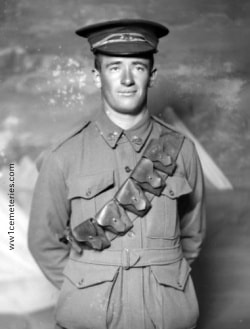
1938 Private
Frank Hillman Hitchins
59th Bn. Australian Infantry, A. I. F.
8th February 1917, aged 21.
Plot VII. K. 3.
Son of M. J. and Julia A. Hitchins, of Hill End, Victoria, Australia.
His headstone bears the inscription "In Memory Of The Dearly Loved Son Of Mr. & Mrs. M. J. Hitchins"
Frank Hillman Hitchins
59th Bn. Australian Infantry, A. I. F.
8th February 1917, aged 21.
Plot VII. K. 3.
Son of M. J. and Julia A. Hitchins, of Hill End, Victoria, Australia.
His headstone bears the inscription "In Memory Of The Dearly Loved Son Of Mr. & Mrs. M. J. Hitchins"
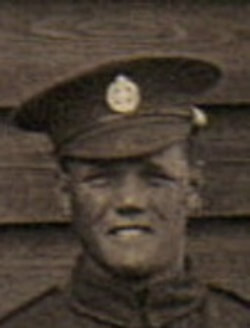
S/34613 Rifleman
Robert Howell
13th Bn. Rifle Brigade
1st October 1918, aged 20.
Plot I. C. 5.
Son of Mr. Howell, of 37, Star Lane, Canning Town, London.
Born in Bromley, Kent. Son of Robert & Susan Howell (nee Fuller), of 37, Star Lane, Canning Town, London. They had 14 children:
Florence Alice Howell (b. 1878), William Robert Howell (b. 1879), Harriet Susan (Doll) Howell (b. 1881), Alfred George Howell (b. 1883), Albert Edward Howell (b. 1885), Henry John C Howell (b. 1887), Charles Robert Howell (b. 1889), Mary Louisa Howell (b. 1891), Rebecca Howell (b. 1892), Ada Elizabeth (b. 1895), Edward Thomas Howell (b. 1896), Robert George Howell (b. 1898), Rosina Winifred Howell (b. 1900), Jessie May Howell (b. 1904).
Resident of Canning Town, Essex. Enlisted at Stratford, Essex.
Information provided by Bill (nephew of Robert) & Hazel Howell
Robert Howell
13th Bn. Rifle Brigade
1st October 1918, aged 20.
Plot I. C. 5.
Son of Mr. Howell, of 37, Star Lane, Canning Town, London.
Born in Bromley, Kent. Son of Robert & Susan Howell (nee Fuller), of 37, Star Lane, Canning Town, London. They had 14 children:
Florence Alice Howell (b. 1878), William Robert Howell (b. 1879), Harriet Susan (Doll) Howell (b. 1881), Alfred George Howell (b. 1883), Albert Edward Howell (b. 1885), Henry John C Howell (b. 1887), Charles Robert Howell (b. 1889), Mary Louisa Howell (b. 1891), Rebecca Howell (b. 1892), Ada Elizabeth (b. 1895), Edward Thomas Howell (b. 1896), Robert George Howell (b. 1898), Rosina Winifred Howell (b. 1900), Jessie May Howell (b. 1904).
Resident of Canning Town, Essex. Enlisted at Stratford, Essex.
Information provided by Bill (nephew of Robert) & Hazel Howell
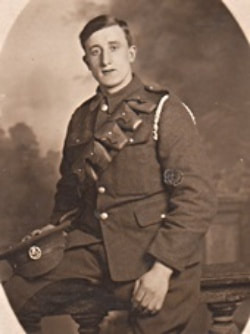
23879 Private
Thomas Robson Irwin
2nd Bn. East Lancashire Regiment
23rd October 1916, aged 23.
Plot VIII. C. 14.
Son of William J. and Margaret Ann Irwin, of Gosforth, Newcastle-on-Tyne.
His headstone bears the inscription "He Lived As He Died A Soldier And A Man"
Image courtesy of niece, Gillian Wilkinson
Thomas Robson Irwin
2nd Bn. East Lancashire Regiment
23rd October 1916, aged 23.
Plot VIII. C. 14.
Son of William J. and Margaret Ann Irwin, of Gosforth, Newcastle-on-Tyne.
His headstone bears the inscription "He Lived As He Died A Soldier And A Man"
Image courtesy of niece, Gillian Wilkinson

5137 Private
George Thomas Laman
2nd Bn. Australian Infantry, A. I. F.
24th December 1916, aged 22.
Plot VIII. D. 9.
Son of Henry and Matilda Laman, of Martin St., Lidcombe, New South Wales. Native of Nelson's Bay.
His headstone bears the inscription "We Loved Him Much Jesus Loves Him More"
George Thomas Laman
2nd Bn. Australian Infantry, A. I. F.
24th December 1916, aged 22.
Plot VIII. D. 9.
Son of Henry and Matilda Laman, of Martin St., Lidcombe, New South Wales. Native of Nelson's Bay.
His headstone bears the inscription "We Loved Him Much Jesus Loves Him More"
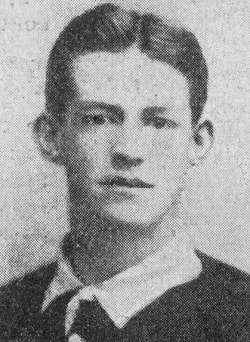
421 Private
Clifford Vernon Love
2nd Bn. Australian Infantry, A. I. F.
24th December 1916, aged 22.
Plot VIII. C. 20.
Son of John and Eliza Love, of Sydney. Native of Walcha, New South Wales.
His headstone bears the inscription "For God & Liberty"
Clifford Vernon Love
2nd Bn. Australian Infantry, A. I. F.
24th December 1916, aged 22.
Plot VIII. C. 20.
Son of John and Eliza Love, of Sydney. Native of Walcha, New South Wales.
His headstone bears the inscription "For God & Liberty"
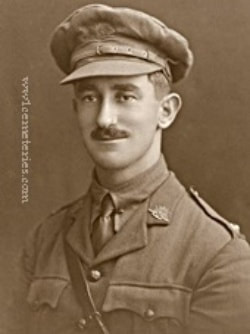
Lieutenant
Walter Fenwick Matthews
13th Brigade, Australian Field Artillery
27th May 1917, aged 30.
Plot II. K. 7.
Son of Walter Alfred and Emmeline L. Matthews, of Clare, South Australia. Native of Clarendon.
His headstone bears the inscription "In Memory Of Dearly Loved Son Of Mr. & Mrs. Matthews Of Clare"
Walter Fenwick Matthews
13th Brigade, Australian Field Artillery
27th May 1917, aged 30.
Plot II. K. 7.
Son of Walter Alfred and Emmeline L. Matthews, of Clare, South Australia. Native of Clarendon.
His headstone bears the inscription "In Memory Of Dearly Loved Son Of Mr. & Mrs. Matthews Of Clare"

23595 Private
Robert Hugh McPhail
2nd Bn. Otago Regiment, N.Z.E.F.
2nd September 1918, aged 34.
Plot I. A. Headstone 12.
Son of James and Annie McPhail, of Waikaka Valley, New Zealand.
Robert Hugh McPhail
2nd Bn. Otago Regiment, N.Z.E.F.
2nd September 1918, aged 34.
Plot I. A. Headstone 12.
Son of James and Annie McPhail, of Waikaka Valley, New Zealand.

Second Lieutenant
Harold Rapley Worsley
"D" Company, 10th Bn. Lancashire Fusiliers
1st September 1918, aged 26.
Plot III. A. 20.
Son of Joseph and Sarah Ann Worsley (nee Barnett).
His headstone bears the inscription "Greater Love Hath No Man Than This That A Man Lay Down His Life For His Friends"
The information below supplied by 'The Ellesmerian Club', the alumni organisation for Ellesmere College where Harold was a pupil.
Harold Rapley Worsley
"D" Company, 10th Bn. Lancashire Fusiliers
1st September 1918, aged 26.
Plot III. A. 20.
Son of Joseph and Sarah Ann Worsley (nee Barnett).
His headstone bears the inscription "Greater Love Hath No Man Than This That A Man Lay Down His Life For His Friends"
The information below supplied by 'The Ellesmerian Club', the alumni organisation for Ellesmere College where Harold was a pupil.
Harold Rapley Worsley was at Ellesmere College for three years from September 1904 to July 1907. He was placed in Form Upper II and, although he was not a first-rate sportsman, he did represent his dormitory, the ‘Edward’, when called upon.
.
Swimming five lengths of the whilst wearing a pair of cricket flannels earnt Harold his swimming certificate in the summer of 1905. In the same term he was playing cricket for his dormitory but scored zero runs.
The Ellesmerian (December 1905) reported that he provided the winning pass in the inter-dormitory football semi-finals and that he was in the side which defeated the ‘Arthur’ dormitory in the final with a score of 12 – 3. He was in the dormitory teams of 1907 for hockey and cricket. In the latter he improved on his previous performance and scored two runs.
Harold was the youngest son of Joseph, a cotton merchant, and his wife, Sarah Ann. His mother came from Tunbridge Wells, Kent, although the family were living at Pendlebury, Lancashire when Harold was born on 27th January 1891.He was the youngest of six children and was, no doubt, kept in his place by three elder sisters Ethel, Lilian and Reta. He was baptised on 6th August 1893 and for the four years prior to his admittance to Ellesmere he was educated at Blackpool High School. By the time of the 1901 Census he was the only member of the family living at home with his parents.
In 1911 he was living with his father, his mother having died the previous year, and was employed as a cotton broker. Two years later he determined to seek a new life the far side of the Atlantic when, on 30th August 1913, he boarded the ss Sagamore bound for the United States. On the passenger manifest he was shown to be 22 years old, his trade was given as that of a ‘grower’ and he was travelling ‘First Class’.
Following the declaration of war he returned home and was living at Chislehurst, whilst working as a merchant when he signed his Attestation Papers on 5th July 1916. On these documents he declared he was single and just over 25 years old. He was embodied to the Royal West Kent (the Queen’s Own) Yeomanry on 10th July as Private Worsley, Service No. 2667. Ten days later he was posted to the 3/1st Battalion which had been formed at the end of 1914 in Canterbury. In the summer of 1916, it was dismounted and attached the 3rd Line Groups of the Home Counties Division at Crowborough as its 1st Line was serving as infantry. In November 1916 it was based at Tunbridge Wells as was finally disbanded in February 1917. In December 1916 Harold was posted to the 3rd Battalion, the Royal West Kent Regiment, a depot / training unit based at Chatham and he arrived at the depot on 19th January 1917.
On 22nd December 1916 Private H. R. Worsley, now Service No. 51716, the Royal West Kent Regiment, formally applied for a commission and duly returned to England to undergo the necessary training after some service in France. He was instructed to report to No. 20 Officer Training Battalion in Hampshire on 6thFebruary 1917.
He successfully completed his course of instruction and was gazetted as 2nd Lieutenant to the Lancashire Fusiliers and joined the 3rd Battalion at Withernsea. He proceeded to France with a draft and was posted to the 11th Battalion, just in time for the Battle of Passchendaele, which he survived. In 1917, the battalion saw action at the battle of Messines attacking between the Wulverghem – Messines and Wulverghem-Wytschaete roads. In the Third Battle of Ypres they saw action during the Battle of Pilkem. In the last year of the war they were in action on the Somme and in the battles of the Lys.
Exactly where Harold served or saw action on a day to day basis is not known but he remained with the 11thBattalion until they were formally disbanded in August 1918. His service records reveal that on 27th May 1918 he saw action at Baslieux as the action that day progressed so quickly that his kit, and that of many other officers, fell into enemy hands, their advance being so swift. He duly filled in the necessary army paperwork to make a claim for the lost kit and to explain why it had been lost.
On 15th July he was posted to the vast Base depot at Etaples and was, towards the end of August, posted to the 10th Battalion, the Lancashire Fusiliers. Just ten days later, whilst involved in an attack on Le Transloy on 1st September, he was killed.
Twelve months later he was re-interred in the cemetery at Bancourt, near Bapaume, where he lies with two men of his battalion next to him. For his wartime service he was awarded the Victory Medal and the British War Medal. He was also ‘Mentioned in Despatches’.
His sacrifice is commemorated on the Blackpool Memorial and the War Memorial outside the Chapel at Ellesmere College.
.
Swimming five lengths of the whilst wearing a pair of cricket flannels earnt Harold his swimming certificate in the summer of 1905. In the same term he was playing cricket for his dormitory but scored zero runs.
The Ellesmerian (December 1905) reported that he provided the winning pass in the inter-dormitory football semi-finals and that he was in the side which defeated the ‘Arthur’ dormitory in the final with a score of 12 – 3. He was in the dormitory teams of 1907 for hockey and cricket. In the latter he improved on his previous performance and scored two runs.
Harold was the youngest son of Joseph, a cotton merchant, and his wife, Sarah Ann. His mother came from Tunbridge Wells, Kent, although the family were living at Pendlebury, Lancashire when Harold was born on 27th January 1891.He was the youngest of six children and was, no doubt, kept in his place by three elder sisters Ethel, Lilian and Reta. He was baptised on 6th August 1893 and for the four years prior to his admittance to Ellesmere he was educated at Blackpool High School. By the time of the 1901 Census he was the only member of the family living at home with his parents.
In 1911 he was living with his father, his mother having died the previous year, and was employed as a cotton broker. Two years later he determined to seek a new life the far side of the Atlantic when, on 30th August 1913, he boarded the ss Sagamore bound for the United States. On the passenger manifest he was shown to be 22 years old, his trade was given as that of a ‘grower’ and he was travelling ‘First Class’.
Following the declaration of war he returned home and was living at Chislehurst, whilst working as a merchant when he signed his Attestation Papers on 5th July 1916. On these documents he declared he was single and just over 25 years old. He was embodied to the Royal West Kent (the Queen’s Own) Yeomanry on 10th July as Private Worsley, Service No. 2667. Ten days later he was posted to the 3/1st Battalion which had been formed at the end of 1914 in Canterbury. In the summer of 1916, it was dismounted and attached the 3rd Line Groups of the Home Counties Division at Crowborough as its 1st Line was serving as infantry. In November 1916 it was based at Tunbridge Wells as was finally disbanded in February 1917. In December 1916 Harold was posted to the 3rd Battalion, the Royal West Kent Regiment, a depot / training unit based at Chatham and he arrived at the depot on 19th January 1917.
On 22nd December 1916 Private H. R. Worsley, now Service No. 51716, the Royal West Kent Regiment, formally applied for a commission and duly returned to England to undergo the necessary training after some service in France. He was instructed to report to No. 20 Officer Training Battalion in Hampshire on 6thFebruary 1917.
He successfully completed his course of instruction and was gazetted as 2nd Lieutenant to the Lancashire Fusiliers and joined the 3rd Battalion at Withernsea. He proceeded to France with a draft and was posted to the 11th Battalion, just in time for the Battle of Passchendaele, which he survived. In 1917, the battalion saw action at the battle of Messines attacking between the Wulverghem – Messines and Wulverghem-Wytschaete roads. In the Third Battle of Ypres they saw action during the Battle of Pilkem. In the last year of the war they were in action on the Somme and in the battles of the Lys.
Exactly where Harold served or saw action on a day to day basis is not known but he remained with the 11thBattalion until they were formally disbanded in August 1918. His service records reveal that on 27th May 1918 he saw action at Baslieux as the action that day progressed so quickly that his kit, and that of many other officers, fell into enemy hands, their advance being so swift. He duly filled in the necessary army paperwork to make a claim for the lost kit and to explain why it had been lost.
On 15th July he was posted to the vast Base depot at Etaples and was, towards the end of August, posted to the 10th Battalion, the Lancashire Fusiliers. Just ten days later, whilst involved in an attack on Le Transloy on 1st September, he was killed.
Twelve months later he was re-interred in the cemetery at Bancourt, near Bapaume, where he lies with two men of his battalion next to him. For his wartime service he was awarded the Victory Medal and the British War Medal. He was also ‘Mentioned in Despatches’.
His sacrifice is commemorated on the Blackpool Memorial and the War Memorial outside the Chapel at Ellesmere College.
Shot at Dawn
11606 Private Wilfred Clarke, 2nd Bn. Durham Light Infantry, executed for desertion on 9th February 1918, aged 23. Plot I. D. 18. Son of William Henry and Elizabeth Louisa Clarke, of 20, Garrick St., Stanhope Rd., South Shields. Two hours before departure for the trenches, he made off, being arrested in Calais 2 months later. (Putkowski, p 235)
11606 Private Wilfred Clarke, 2nd Bn. Durham Light Infantry, executed for desertion on 9th February 1918, aged 23. Plot I. D. 18. Son of William Henry and Elizabeth Louisa Clarke, of 20, Garrick St., Stanhope Rd., South Shields. Two hours before departure for the trenches, he made off, being arrested in Calais 2 months later. (Putkowski, p 235)

